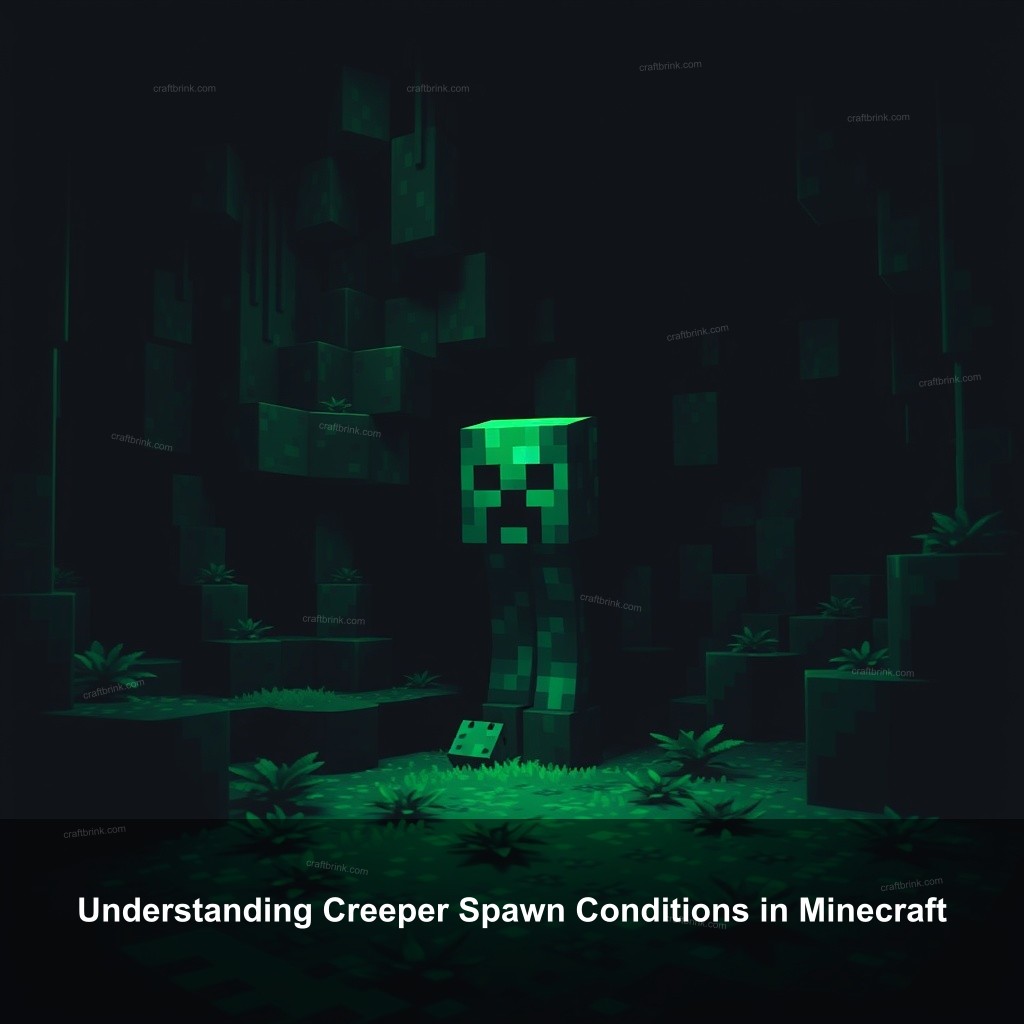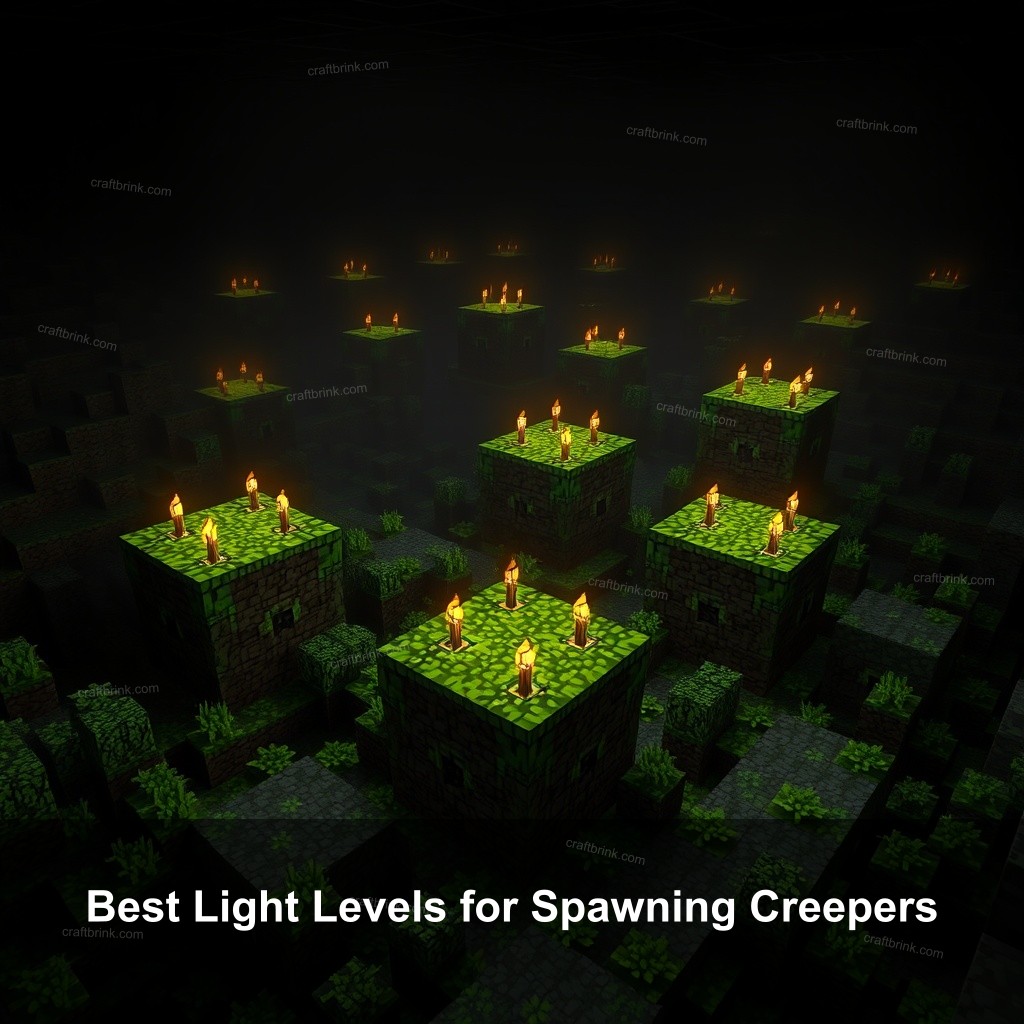Have you ever wondered why creepers seem to spawn in your Minecraft world at the most inconvenient times? Understanding light levels for creeper spawning can change the way you approach your gameplay. In this article, brought to you by CraftBrink, we will dive into the factors that affect creeper spawns and how you can optimize your creeper farms.

Understanding Creeper Spawn Conditions in Minecraft
To grasp the intricacies of creeper spawn conditions, we first need to outline the essential criteria that govern their appearance in the game. Creepers are unique mobs that thrive under specific circumstances, primarily defined by light levels, block types, and player proximity. Creepers will only spawn in areas where the light level is 7 or less, making it essential to manage your environment effectively.
| Factor | Description |
|---|---|
| Light Level | Must be 7 or lower for creepers to spawn. |
| Block Type | Creepers need solid blocks to spawn on. |
| Proximity to Players | Nearby players can affect the mob cap. |
For instance, if you are building a creeper farm, positioning it in an area with minimal external light sources is vital. One common mistake is having bright torches nearby, which can drastically reduce spawn rates. Another factor is proximity to other players; if they are too close, they can affect spawn rates by occupying the mob cap.
What Are Creeper Spawn Conditions?
Understanding creeper spawn conditions requires a look at several critical elements. First, creepers require solid blocks to spawn on, with a preference for locations that are not obstructed by other mobs. The light level plays a crucial role, as creepers only appear in dark areas. Ideally, you should strive for a light level of 0 to maximize your chances of spawning creepers.
For example, if you’re crafting a farm, positioning it in a dark environment free from bright light sources is crucial. By managing these factors, you can increase your odds of having creepers spawn consistently.
Importance of Light Levels
Light levels are the first hurdle for any player attempting to spawn creepers. A light level above 7 will prevent them from appearing, making it crucial to keep the area dark. This is especially important when building creeper farms. For example, if you’re crafting a farm near a cave, it’s beneficial to illuminate the cave to minimize potential mob spawns there.
Players often overlook how light levels differ between biomes. In a forest biome, natural light can be obstructed by the dense foliage, which may be advantageous for creepers. Knowing your environment will help you create the best possible spawning conditions.
Environmental Factors
Environmental features can significantly influence creeper spawn conditions. Caves, water bodies, and other obstacles can hinder your efforts. For example, if your farm is near a large cave system, creepers may spawn there instead of your designated area. To mitigate this, consider lighting up nearby caves or blocking them off if possible.
Additionally, if you’re building a farm in an ocean biome, you may enjoy the added benefit of fewer competing mobs, allowing creepers to spawn more freely. Understanding these nuances will aid in setting up an effective farm.

Best Light Levels for Spawning Creepers
After establishing the conditions necessary for creeper spawns, it’s time to discuss the best light levels for maximizing your chances of encountering them in Minecraft. Achieving the optimal light level is key to successful creeper farming.
Optimal Light Levels
The best light level for spawning creepers is 0, but levels up to 7 can still yield results. To effectively manage light levels in your creeper farm, you might want to use various light sources strategically. For instance, if you have torches, place them at least 9 blocks away from your spawning platform to avoid interfering with the light level.
- Use darker surfaces for maximum spawn potential.
- Check your farm’s light level using night vision potions.
- Adjust your farm layout based on local light sources.
To easily monitor your farm’s light level, consider using a night vision potion or checking the light level indicated in the game. Over time, you’ll become adept at gauging what works best for your particular setup.
Light Source Effects
Different types of light sources can affect spawning conditions differently. For example, while torches provide a warm light, glowstone emits a more intense brightness that can impact spawning if placed too closely. Knowing how various light sources behave will help you design your creeper farm effectively. A good rule of thumb is to avoid any bright light sources near your spawning platforms altogether.
To illustrate, using redstone lamps can be beneficial because of their ability to turn off and on. This allows you to control the light level dynamically, optimizing your farm as needed.
Common Mistakes in Light Management
Players often make the mistake of mismanaging their light sources. If you find that your creeper farm isn’t yielding results, first check the light levels. Bright torches placed too close to the spawning area can significantly diminish your spawn rate. It’s crucial to ensure that all surrounding areas are dark enough to allow creepers to spawn unencumbered.
Another mistake is neglecting nearby ambient light sources, such as lighting from villagers or other players. These can inadvertently affect your spawn rates, so monitor your environment carefully.
How Light Levels Affect Creeper Spawning
The relationship between light levels and creeper spawns is critical to grasp. As you become more familiar with the mechanics, you’ll be able to adapt your strategies accordingly.
The Science Behind Light Levels
Light levels in Minecraft are calculated based on several factors, including natural light and artificial sources. When you break a block, that block checks for light levels from surrounding blocks, affecting the overall spawn mechanics.
This means that if you have a block adjacent to a light source, the light level can propagate to your spawning area. Therefore, understanding how light levels work can significantly enhance your gameplay experience.
Interaction with Other Mobs
Creepers are not the only mobs affected by light levels. Other mobs can also influence how creepers spawn. For instance, if you have pig or cow mobs nearby, they could occupy the mob cap, leaving less room for creepers to spawn.
In some cases, players have found that constructing their farms away from busy areas yields better results as it reduces competition for the mob cap.
Seasonal Changes
As seasons change in the game, players may notice fluctuations in light levels. During specific times of day, such as dusk or dawn, natural light can shift dramatically, influencing your creeper spawning patterns.
Being aware of these changes can help you time your farming sessions better, ensuring you’re optimizing conditions for the best possible results.
Creeper Light Mechanics and Their Impact on Spawning
Understanding creeper light mechanics is crucial for any serious Minecraft player. This knowledge will enhance your gameplay and help you create better strategies for spawning these elusive mobs.
Creeper Behavior Relative to Light Levels
Creepers react distinctively to light levels. When the environment is dim, they tend to spawn more frequently, while in bright areas, you’ll find them scarce. This means players must constantly monitor their surroundings to avoid unwanted encounters.
For example, if you notice a significant drop in the number of creepers spawning, first check the light levels before making any drastic changes to your farm. Knowing how light impacts creeper behavior will help you strategize better.
Strategic Light Placement
Strategically placing light sources in your creeper farm can significantly enhance your spawning ability. For instance, if you choose to use light sources, position them at least nine blocks from the creeper spawning area to ensure they don’t interfere.
Incorporating light management techniques will not only attract more creepers but also create a safer environment for farming.
Lighting Tools and Techniques
Players have various tools at their disposal for managing light levels effectively. From torches to redstone lamps, knowing how each tool operates will empower you to make informed decisions. Redstone lamps, for example, offer flexibility in lighting management, allowing you to turn them off when not needed.
Using these tools correctly can make a significant difference in your overall spawn rates.
Conditions Necessary for Creeper Spawns
To ensure successful creeper spawns, players must understand the conditions required. These factors are critical for creating an efficient creeper farm.
Essential Environmental Conditions
When considering the conditions necessary for creeper spawns, several important aspects come into play. Solid blocks are essential for creepers to spawn upon. It’s important to note that certain blocks like glass or leaves do not count as spawnable surfaces.
Setting up your creeper farm requires a thorough understanding of these environmental conditions to maximize efficiency.
Spatial Requirements
Creepers require adequate space to spawn. They need a minimum of two blocks of vertical space, so when designing your farm, ensure your spawning platforms allow for this. Keeping your farm spacious will result in more efficient spawn rates.
For instance, if your farm is too cramped, it may lead to fewer spawns or even an outright failure. Keep this in mind when you plan the layout.
Impact of Surrounding Biomes
The biome you choose can have a significant impact on creeper spawn rates. Some biomes, like deserts, offer fewer spawns due to higher temperatures. In contrast, other areas like oceans provide a more favorable environment for creepers.
Understanding these differences will help you strategically choose where to set up your farms for maximum efficiency.
Advanced Strategies for Optimizing Creeper Spawns
As you become more adept at managing your creeper spawns, consider adopting advanced strategies to further enhance your farming efficiency. This can include more effective farm designs and monitoring environmental conditions.
Designing Effective Creeper Farms
When crafting an effective creeper farm, consider the layout and spacing of your platforms. A well-designed farm should incorporate multiple layers to maximize spawn rates. A popular design is the multi-layered farm, which integrates various spawning platforms.
Building a creeper farm with enough space and proper lighting management will significantly increase your yield. It’s beneficial to research existing designs and see how you can adapt them to your needs.
Managing Environmental Variables
Keeping track of external environmental factors is essential for maintaining optimal spawn conditions. This includes managing light levels and surrounding mobs. Regularly check on your farm and adjust as necessary to ensure your creepers are thriving.
You may need to periodically return to your farm to make adjustments based on changing conditions.
Troubleshooting Common Issues
Even with the best strategies in place, issues can arise. If you notice a drop in spawning rates, first assess the light levels and the surrounding environment. Common problems often stem from nearby light sources or mob competition.
By troubleshooting these common pitfalls, you can quickly get your farm back on track.
FAQ
What light level do creepers need to spawn?
Creepers need a light level of 7 or lower to spawn. The optimal light level for spawning is 0.
How do environmental factors impact creeper spawns?
Environmental factors like nearby caves, other mobs, and biome types can greatly affect creeper spawning rates.
What is the best way to build a creeper farm?
The best creeper farms incorporate multiple layers, adequate lighting management, and ample space to allow for efficient spawning.
How can I increase my chances of spawning creepers?
To increase your chances, ensure your farm is built in a dark area, far from bright light sources, and optimize the layout for maximum space and light level management.
Can creepers spawn during the day?
Creepers can spawn during the day, but only in areas with a light level of 7 or lower. Typically, it’s easier to spawn them at night.
Conclusion
In conclusion, understanding light levels for creeper spawning is important for any Minecraft player looking to enhance their gameplay. By managing light levels, environmental factors, and spatial requirements, you can optimize your creeper farms for the best results. We encourage you to share your thoughts or experiences regarding creeper spawning in the comments below. For more valuable insights, visit CraftBrink at craftbrink.com.
